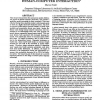Free Online Productivity Tools
i2Speak
i2Symbol
i2OCR
iTex2Img
iWeb2Print
iWeb2Shot
i2Type
iPdf2Split
iPdf2Merge
i2Bopomofo
i2Arabic
i2Style
i2Image
i2PDF
iLatex2Rtf
Sci2ools
NAACL
1994
1994
Predicting and Managing Spoken Disfluencies During Human-Computer Interaction
This research characterizes the spontaneous spoken disfluencies typical of human-computer interaction, and presents a predictive model accounting for their occurrence. Data were collected during three empirical studies in which people spoke or wrote to a highly interactive simulated system. The studies involved within-subject factorial designs in which input modality and presentation format were varied. Spoken disfluency rates during human-computer interaction were documented to be substantially lower than rates typically observed during comparable human-human speech. Two separate factors, both associated with increased planning demands, were statistically related to increased speech disfluency rates: (1) length of utterance, and (2) lack of structure in the presentation format. Regression techniques revealed that a linear model based simply on utterance length accounts for over 77% of the variability in spoken disfluencies. Therefore, design techniques capable of channeling users...
Related Content
| Added | 02 Nov 2010 |
| Updated | 02 Nov 2010 |
| Type | Conference |
| Year | 1994 |
| Where | NAACL |
| Authors | Sharon L. Oviatt |
Comments (0)

